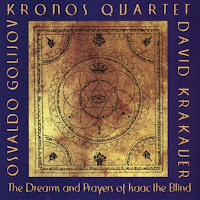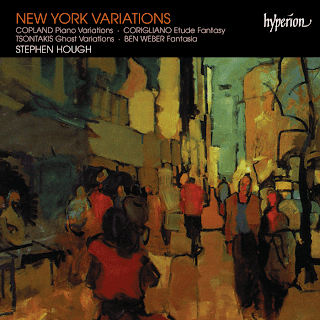Symphony nr. 1 - Philharmonia Orchestra, Otto Klemperer, 1957
Symphony nr. 2 - NDR Sinfonieorchester, Günter Wand, 1988
Symphony nr. 3 'Eroica' - Vienna Philharmonic Orchestra, Georg Solti, 1959
Symphony nr. 4 - Berlin Philharmonic Orchestra, Herbert von Karajan, 1962
Symphony nr. 5 - Berlin Philharmonic Orchestra, Lorin Maazel, 1958
Symphony nr. 6 'Pastorale' - Orchestra National de France, Rafael Kubelik, 1976 (LP)
Symphony nr. 7 - Berlin Philharmonic Orchestra, Karl Böhm, 1958
Symphony nr. 8 - Berlin Philharmonic Orchestra, Eugen Jochum, 1959 (LP)
Symphony nr. 9 - Cleveland Orchestra, Christoph von Dohnanyi, 1985
So it transpires that 6 out of 9 were drawn from a 'golden age of stereo recording' between 1958 and 1962. Four happened to be performed by the Berlin Philharmonic, under four different conductors. Three of these recordings were made in the space of just a few months time (Böhm's Seventh was recorded in April 1958, Jochum's Eighth early May and Maazel followed suit with his Fifth in May and June of that same year!).
 I did not listen in numerical order but chronologically jumped to and fro. The highlight of the cycle was, perhaps, Böhm's Seventh which is a glorious reading captured in a sound that is astonishingly lively and rich for the era. It's a grand and luxurious approach but one that does justice to the unflagging energy that pervades this work. Another great recording is Wand's Second. This is a more recent interpretation but still very traditional. Still, I couldn't care less as Wand's grasp of the architecture is awe-inspiring. Listening to this interpretation just feels very right. I haven't heard any of the other recordings in his NDR-cycle but I expect this to be quite rewarding.
I did not listen in numerical order but chronologically jumped to and fro. The highlight of the cycle was, perhaps, Böhm's Seventh which is a glorious reading captured in a sound that is astonishingly lively and rich for the era. It's a grand and luxurious approach but one that does justice to the unflagging energy that pervades this work. Another great recording is Wand's Second. This is a more recent interpretation but still very traditional. Still, I couldn't care less as Wand's grasp of the architecture is awe-inspiring. Listening to this interpretation just feels very right. I haven't heard any of the other recordings in his NDR-cycle but I expect this to be quite rewarding.
 Very good also was Karajan's Fourth in his second rendering of the complete cycle, from 1962. Despite its apollinian credentials I was struck by the nervous energy that radiates from this recording. Contrary to what might be expected, I had a similar impression from Klemperer's fleet-footed and authoritative First. I also liked Solti's Eroica which struck me as rather Kapellmeisterisch, but in a good sense. No histrionics, but a solid and contained reading that one is tempted to revisit. Also the sound of this 1958 tape is very good with the 'nutty', 'earthy' character of the Vienna PO wel captured. I acquired Jochum's Eighth, in a cheap LP pressing for DGG's Resonance series, very early on in my musical explorations and so I'm very familiar with it. Still I haven't tired of this lean and boisterous reading. Also commendable is Dohnanyi's Ninth with the Cleveland Orchestra and a fine quartet of soloists. The music's drive is slightly blunted by Telarc's characteristically soft-grained recording but the overall effect is of an invigorating, timeless classicism.
Very good also was Karajan's Fourth in his second rendering of the complete cycle, from 1962. Despite its apollinian credentials I was struck by the nervous energy that radiates from this recording. Contrary to what might be expected, I had a similar impression from Klemperer's fleet-footed and authoritative First. I also liked Solti's Eroica which struck me as rather Kapellmeisterisch, but in a good sense. No histrionics, but a solid and contained reading that one is tempted to revisit. Also the sound of this 1958 tape is very good with the 'nutty', 'earthy' character of the Vienna PO wel captured. I acquired Jochum's Eighth, in a cheap LP pressing for DGG's Resonance series, very early on in my musical explorations and so I'm very familiar with it. Still I haven't tired of this lean and boisterous reading. Also commendable is Dohnanyi's Ninth with the Cleveland Orchestra and a fine quartet of soloists. The music's drive is slightly blunted by Telarc's characteristically soft-grained recording but the overall effect is of an invigorating, timeless classicism.  The young Lorin Maazel recorded a heaven-storming Fifth with the distinguished Berlin Philharmonic. At the time it was damned by the critics because of its expressive idiosyncracies but today we'd say that Maazel was ahead of his time. Still, I felt unconvinced by this effort. The low point of the cycle was Kubelik's Pastoral with the Orchestra National de France. It is part of a LP box with a full cycle, of which each symphony is played by another orchestra. The opening movement is beguiling enough, played by Kubelik with an almost Bohemian generosity. But in the Andante (Scene by the Brook) all momentum is lost and even the Storm is not able to quicken the pulse. At the end the impression is one of overwhelming boredom.
The young Lorin Maazel recorded a heaven-storming Fifth with the distinguished Berlin Philharmonic. At the time it was damned by the critics because of its expressive idiosyncracies but today we'd say that Maazel was ahead of his time. Still, I felt unconvinced by this effort. The low point of the cycle was Kubelik's Pastoral with the Orchestra National de France. It is part of a LP box with a full cycle, of which each symphony is played by another orchestra. The opening movement is beguiling enough, played by Kubelik with an almost Bohemian generosity. But in the Andante (Scene by the Brook) all momentum is lost and even the Storm is not able to quicken the pulse. At the end the impression is one of overwhelming boredom. After such a long time away from Beethoven, it was a fascinating journey. The music sounded genuinely fresh and often I was struck by Beethoven's modernity. There is a primitivist streak in this music which bursts out in obsessive rhythms or withdraws in extended, murky transitions (though never, it seems, gratuitous but with a deeper musical logic underpinning them). Listening through this cycle also confirmed that good music-making is timeless and whether it is branded 'traditional' or 'historically informed' doesn't matter in the least.





























